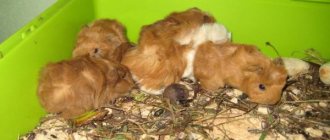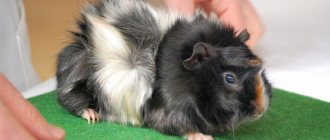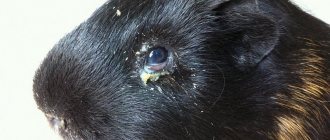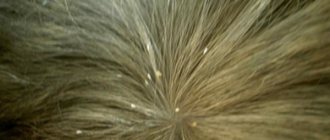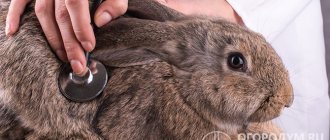Your pet guinea pig sneezes frequently. In most cases, this is justified, because involuntary exhalations help the animal clear the nasal passages of dust and other irritants. However, if sneezing repeats again and again, accompanied by discharge, this symptom cannot be ignored. It may signal developing bronchitis or pneumonia. Therefore, the owner must understand what signs of diseases are sneezing and coughing in a guinea pig.
The main causes of sneezing: norm and deviations
You need to start with cases when you don’t need to worry about your pet’s health:
- Sneezing can be caused by common dust. If your pet starts sneezing uncontrollably while cleaning the room, this only indicates that you need to do wet cleaning more often.
- Reaction to perfume or other cosmetics. Because of this, by the way, there is no need to place a cage with a pet near tables with cosmetics and household chemicals.
- Pigs often react by sneezing to a portion of fresh hay, new litter, new food, etc. In these cases, the reasons vary from the same dust (which is especially abundant in hay) to allergies.
It is necessary to call a veterinarian in the following cases:
- The sneezing is sharp, strong, as if the mumps are “throwing up”, the frequency of attacks increases.
- It is accompanied by severe wheezing, hissing, and other signs that something is wrong.
- Mucus or blood is released from the animal's nose.
- After bouts of sneezing, the pet lies on its back or side, opens its mouth wide and sucks in air noisily.
- You urgently need to call a specialist when your pet begins to swell and its visible mucous membranes (including those on the nose and eyes) turn blue. This indicates a severe lack of oxygen.
Cold
As a rule, pigs get colds due to hypothermia
It happens due to a draft, the pet being close to windows and doors, or careless transportation. In some cases, the animal becomes infected from people or other animals
Signs of a cold in a rodent:
- temperature 40–41 degrees;
- loss of appetite;
- cough, sometimes with sputum;
- wheezing during breathing;
- apathy;
- redness of the eyes and watery eyes;
- the pet sneezes and snot flows profusely.
In advanced cases, a cold develops into more dangerous rhinitis, bronchitis, pulmonary edema or pneumonia
Therefore, it is important to “catch” the disease at an early stage
Treatment consists of rinsing the nose with an antiseptic and instilling immunomodulators. In severe cases, the doctor prescribes antibiotics (for example, Baytril). Recovery will be accelerated by taking vitamin C and expectorants.
The main diseases of guinea pigs accompanied by sneezing
Below we list the main diseases of guinea pigs accompanied by sneezing. Some of them do not require veterinary intervention, while in other cases immediate assistance from an experienced specialist is required.
Allergy
One of the most common causes of sneezing is allergies. It can arise for anything. If the owner notices that when using a new litter or food, the pig begins to sneeze and itch furiously, there is a high probability that this is the case.
Otitis media, causes itching and pain in the ears
Finally, another reason why your puppy is itching could be an ear infection if he is scratching the ear or head area. This disease is quite common in puppies, especially after bathing. This condition will cause your puppy to frantically scratch his ears, tilt his head toward the affected ear, and shake his head violently, among other symptoms. If you find this in your dog, you should take him to the vet so that he can give you the best treatment to make his ear infection heal as quickly as possible. Now you know several possible reasons and know that you should contact a specialist who will help your little and faithful companion in the best possible way.
Author of the article: Irene Juste. Veterinary assistant. I am a veterinarian technical assistant with various specializations in various areas such as felines and exotic animals. Currently, I have decided to pursue training in international trade and marketing, among other things, to be able to more easily fight for animals in this human world. I am a fighter and very active, I cannot stand aside. I have been a part of various volunteer activities so I always encourage respect for animals and promote their adoption.
Associated symptoms (and their explanation)
The following accompanying symptoms (and their explanation) are extremely important. If they are interpreted correctly, they can save your pet's life or significantly speed up its recovery in the future.
Snot, nasal discharge
As a rule, snot and nasal discharge may indicate:
- Colds. In this case, the mucus is an inflammatory exudate.
- Allergies. In this case, it is rather not snot that is released from the nose, but a liquid, transparent exudate. This also indicates the onset of the inflammatory process.
- Snot may be a response to large amounts of dust entering the respiratory tract. The body tries to flush out excess from the upper respiratory tract.
- Presence of a foreign body. As in the previous case, the body tries to create conditions for the natural removal of waste.
Sneezing without snot from the nose
If the animal just has sneezing, without snot from the nose, then this may be a sign of:
- The presence of a large amount of dust in the air, when its particles irritate the mucous membranes of the respiratory tract.
- This happens when allergies or a cold begin, but soon snot (as a result of inflammation) will still appear.
- It is possible that something got into the pig’s nose, but this “something” has already safely flew out when sneezing.
What to do if your budgie sneezes?
This symptom can be caused by an allergy. It can appear in a pet due to unsuitable food of poor quality, an unusual fruit or vegetable for the bird, or a sudden change in diet. This causes weakened immunity. To prevent this from happening, feed your bird with non-cheap feed mixtures. From them, the pet will be able to get all the necessary vitamins and minerals, as well as those substances that will not allow the immune system to weaken.
When you have a cold, warming is necessary, the same as what cockatiels need. This procedure is described in the text above.
If nasal discharge is noticed, inhalation is necessary.
To do this you need:
- 5 drops eucalyptus oil
- A bowl with a capacity of 100 milliliters filled with hot water (boiling water).
Add drops of eucalyptus oil to boiling water, place the bowl in the cage and cover the cage with a fairly thick towel for ten minutes. The main thing at this time is to keep an eye on your pet. It should not be allowed to be too close to boiling water, otherwise it may get burned.
The above treatment is suitable not only for budgerigars, it will also be the answer to the question “What to do when a cockatiel parrot sneezes,” since it is also quite suitable for representatives of the cockatiel species.
Remember that if symptoms do not go away after several days of warming and inhalation, it is necessary to contact a veterinarian.
- about the author
- Recent publications
Inna Grabovaya
Candidate of Veterinary Sciences
Inna Grabovaya recently published (view all)
- DIY parrot cage -
- Does a budgie need a mirror?
- Perches for parrots -
Diagnostic methods
Often the diagnostic methods used are not particularly diverse. The veterinarian collects a detailed medical history. It is important for the specialist to know whether the animal received new types of food, whether there were any cases of hypothermia, etc.
But still, an accurate diagnosis can only be made on the basis of a full clinical examination of mumps:
- A phonendoscopy is performed (the pet's chest cavity is listened to).
- If necessary and if an infection is suspected, a complete blood test, microscopy and serology (usually an ELISA reaction) are performed.
- Discharge from the nose and eyes is examined under a microscope.
- In doubtful cases, the resulting material is sown on nutrient media in order to accurately identify the type of pathogenic microorganism.
Pneumonia
Inflammation of the lungs in guinea pigs most often occurs when the animal is hypothermic during the demi-season period; sometimes furry animals become infected with infectious pneumonia from sick relatives. The pathology is dangerous due to its rapid progression and death of the animal.
You can determine that your favorite rodent has pneumonia by the characteristic symptoms:
- the guinea pig sneezes, coughs, wheezes, and breathes heavily;
- the furry animal refuses food, stops playing with its relatives and owner;
- There is lacrimation and purulent discharge from the nose.
If you suspect your pet has pneumonia, you should immediately see a doctor.
The outcome of the disease directly depends on the timeliness of the owner of a sick animal contacting a specialist and the correctness of the prescribed therapy.
If your guinea pig is sneezing and wheezing, it is recommended to immediately call a doctor at home.
To treat pneumonia in domestic rodents, injections of sulfonamide or antibacterial drugs, nasal rinsing followed by instillation of vasoconstrictors and anti-inflammatory drugs, drinking vitamins, expectorants and strengthening herbal decoctions are used.
Owners of guinea pigs are advised to be attentive to their beloved pets; if a funny animal often sneezes, refuses food, or constantly rubs its nose, it is advisable to urgently contact a veterinary clinic to avoid the development of severe, deadly pathologies.
What to do if your guinea pig sneezes 5 (100%) 1 vote
An approximate treatment plan for a sick pig
It is easy to understand that the specific treatment regimen will directly depend on what exactly is causing the sneezing:
- In case of allergies, you need to isolate your pet from the action of those factors and substances that caused this allergy. For mild allergies, this is quite enough, but in other situations, antihistamines will be required. We recommend using medications in drop form ( Zyrtec , for example), as they are much more convenient to dose. Medicines are given approximately once a day, the duration of treatment is about 5 days.
- Both in case of allergies and colds, it is very important to clean the animal’s nose from accumulated exudate and dried crusts. To do this, you need to rinse your nose. It is best to use warm saline solution for this purpose (it is completely safe) and the smallest baby syringe with a soft and long tip. At the end of the procedure, the animal’s nose is wiped dry and derinat (up to 3 times a day, drop by drop). The duration of treatment is about three days, but it can be extended if necessary.
- For colds, your pet is prescribed antibiotics. Rodents best tolerate drugs from the cephalosporin group. The dose, specific medicine and duration of use should only be calculated by a veterinarian!
Sneezing as an allergy
In many animals, pigs are no exception in this series; an allergic reaction can manifest itself as a reflex sneezing. In this way, the body tries to get rid of the allergen that has entered the nasal cavity.
As a rule, in domestic rodents the cause of respiratory allergic sneezing is trivial and does not require serious investigation. This may include reactions to:
- new, previously unused filler; hay (by the way, in the case of this product, the allergen will be not only dust, which can be present in any feed, and even less so in low-quality feed, but also weeds); industrially produced food (although in this case, in addition to sneezing, there may be other signs of allergy: rash on the skin, itching, redness of the mucous membranes and much more).
When a guinea pig sneezes, be sure to conduct an external examination of the animal to assess the general condition of the pet. As a rule, if you are allergic to dust and other substances, you will also experience lacrimation and slight itching in the mouth and nose (scratch marks are visible). Be sure to pay attention to the nature of the discharge - with a non-infectious onset, they are light, transparent, liquid and without an unpleasant odor.
Allergy treatment methods and prevention
The question naturally arises: what to do if your guinea pig sneezes? In case of allergies, the issue is resolved quite quickly and simply:
1. First of all, find out the source of the allergen and exclude the animal’s contact with it.
To do this, analyze all the changes that could have occurred over the last week or ten days:
- whether the litter was changed; it may be that ready-made food from an unknown company was introduced, which had not previously been used in the rodent’s diet; A new package of hay was purchased.
They pay attention to every little thing, right down to replacing an old toy with a new one - after all, even the components of the material from which it is made can cause allergies, and, consequently, sneezing.
2. Carry out the necessary therapeutic measures.
Although in some cases it will be enough to simply eliminate the effect of the allergen so that the pet’s condition stabilizes and returns to normal, sometimes it is necessary to resort to the use of antihistamines. Any children's anti-allergy suspension is suitable for these purposes. In this case, the dose must be calculated based on the weight of the rodent. The frequency of giving the drug is once a day, three or four days.
To prevent an allergic reaction, always pay attention to the quality of the feed and bedding that is purchased. Don’t forget to keep statistics on the types and manufacturers of goods that caused incidents in order to avoid unpleasant symptoms in the future.
This pathological condition is not a disease as such, but rather will be a response to hypothermia. The disease manifests itself not only by sneezing, but also by:
- a slight increase in body temperature (the norm for pigs is 37.5-39.5 ° C), poor appetite, deterioration in mood; ruffled coat; redness of the eyes, watery eyes; heavy or rapid breathing; the nose is clogged with thick contents, which is why the pig “grunts” or “sniffles”; in some cases, thick green or brownish mucus is released from the nasal openings.
If you don’t assess your pet’s health in time and leave everything to chance, then in most cases a cold will turn into bronchitis or, even worse, pneumonia. Therefore, at the first symptoms or suspicion of hypothermia, the mumps must be treated.
First of all, it is necessary to clear the nasal passages of contents. To do this, the nose is washed with saline or chlorcesidine (literally a drop in each passage). After that, the nasal mirror is wiped with a napkin and then derinat is instilled. Usually after it the animal sneezes heavily, which is the norm.
It is better to bury it together: one holds the piglet by the body, and the second person tilts the pet’s head back and carefully, using a syringe without a needle, injects the medicine into each nostril (one drop into each).
To boost immunity, ascorbic acid is added to the water; by the way, it should generally be present in the animal’s diet every day. During illness, the dose is 1.5-2 ml of a 5% vitamin C solution per adult pig once a day.
Echinacea tincture (up to 5 drops per head), gamavit (1 ml in water) also contributes to rapid recovery - both of these drugs are considered immunomodulators.
Instead of water, you can give chamomile infusions, breast milk and other anti-inflammatory herbs.
If there is wheezing in the chest, antibacterial drugs are prescribed. For these purposes, children's cold medicines, for example, Biseptol, are again suitable. You can buy Baytril (sold at a veterinary pharmacy). You need to be careful when prescribing antibiotics, as some are deadly to guinea pigs. Therefore, it is better to leave the choice of drug to your veterinarian.
Any antibiotic causes dysbacteriosis, to avoid it, bifidobacteria must be given.
It is recommended to use children's bromhexine as an expectorant (1 drop per day by mouth).
You should not self-medicate and if you suspect a serious illness, or even better, in any case, your pet is feeling unwell, seek help from a qualified specialist who can make a diagnosis and prescribe adequate treatment.
Prevention
To prevent colds, it is important to follow the rules and regulations:
- firstly, drafts are avoided: the cage is installed away from windows, entrance doors, in a warm and dry room; secondly, the temperature in the room should not be lower than 18 °C; thirdly, pay attention to the litter: it should not be wet, rotten or damp.
Experienced breeders recommend setting up the bottom of the cage where guinea pigs are kept like a three-tier sandwich:
A thin layer of filler - medium fraction granules; Wood sawdust; Thick layer of hay.
As often as possible, check the corners where babies most often defecate, and the place under the feeder and drinking bowl. If moisture is observed there, it is better to replace the litter with a new one. In any case, the shift is carried out at least once a week.
You should not walk with your pet in the cold season, and if due to circumstances you have to travel, then the animal is provided with the most comfortable and warm conditions.
Sneezing is a sign that forces you to pay close attention to the health of your guinea pig. You should never treat this symptom negligently and you must find out its cause, and then begin treatment.
Prevention of colds
Thus, timely prevention of colds can eliminate many problems:
- The cage is never placed near windows, doors (especially entrance doors that separate the house from the street), radiators, cold/hot water supply risers, etc. In all these cases, temperature changes will always occur in the pet’s home.
- Experienced “pig breeders” believe that the optimal temperature in a room with a cage is from 19°C to 23°C.
- There should always be sufficient bedding in the cage and be dry.
The last point is perhaps the most important. But maintaining dryness in the case of pigs can be difficult. To keep the litter dry as long as possible, it is made of three layers:
- Wood pellets of cat litter are used as the first layer.
- The second layer is sawdust from deciduous (very desirable) wood.
- Hay or high-quality straw is placed on top.
It is advisable to change the areas under the drinking bowl and latrine either daily or every other day. Complete replacement of litter - once a week.
Teaching proper manners
If the animal bites (not in the form of a show of love, but in real pain), you need to carefully place it back into the home
During subsequent communication, you need to show maximum care. It is important to monitor which parts of the pet’s body are touched by the animal, and which, on the contrary, causes discomfort and causes protest on the part of the little pet.
Manifestations of friendliness in the behavior of a pet should be encouraged - give the animal treats. Gradually, the duration of the communication session with your pet should be increased.
The greatest result of taming is achievable while the animal is in childhood
That is why it is important, even in infancy, to accustom your pet to unpleasant procedures and processes necessary for care and maintaining hygiene. To minimize stress, you should follow simple rules:
- do not force the animal if it shows strong dissatisfaction with what is happening;
- eliminate external stimuli (sources of noise, etc.);
- do not disturb the animal during the adaptation period.
How to tame
Competent training is carried out like this:
- A finger is placed on the cage and removed if the pig shows aggression. The animal needs to say “no” - in a firm voice, but without raising the tone.
- The pig is given a treat, after which the finger is again applied to the bars of the cage. If your pet tries to bite again, you need to show him the gift, but you cannot give it away.
This process must be repeated every day until the result is achieved - the animal stops trying to “grab” the finger. Treats are the best motivation for a small rodent in any circumstances (reviews from owners are the main confirmation of this). The success of training will not be long in coming.


